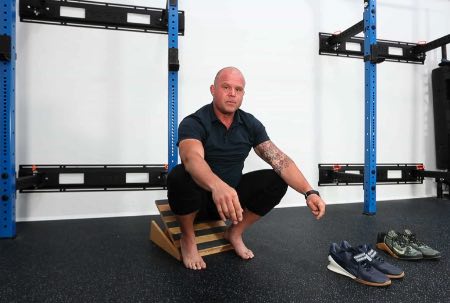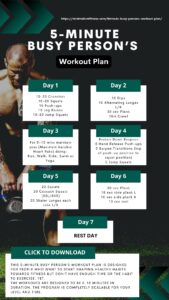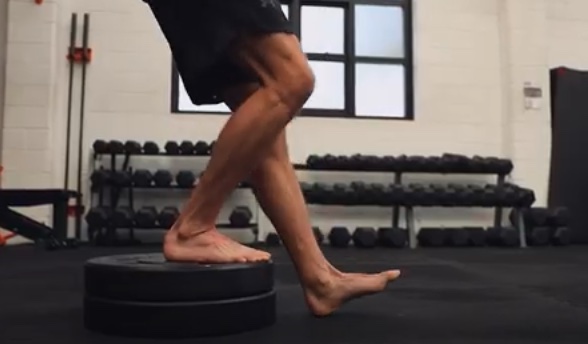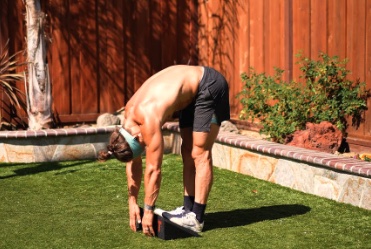There’s been a lot of buzz around the slant board lately. Thanks to the knees over toes guy, the slant board has made a huge jump from a piece of equipment you use in rehab to reduce ankle range of motion to a mainstream fitness tool nearly everyone can use.
Read on if you want to learn the essentials of the slant board to get the most out of your training.
Key Takeaways:
- The slant board is a great tool for any home gym or commercial gym
- Slant board exercises offer the ability to elevate traditional human movements such as squats
- The slant board also gives the fitness enthusiast access to lee traditional movements such as sissy squats and Jefferson curls

5 essential slant board exercises
1. The Sissy Squat
Also known as the KOT (knees over toes) squat, this is pretty much any squat you can do on a slant board as your toes will always go over your toes. The advanced version of the sissy squat sees you drop your knees to the floor but let’s bring it back a notch for beginners:

- Start with bodyweight only and ensure you get to full depth in your KOT squat. You can also start with an exercise like reverse nordics
- When you’re ready, add some load using a kettlebell or dumbbell in a goblet squat position
- From here you can increase load or add a barbell, be sure not to load heavy and be prepared to take your time to ensure safe progress.
- Once you’ve mastered these levels, work towards the advanced version of the sissy squat if you feel you need to
Related Posts:
Get Fit in 5 Minutes

Too Busy to Work Out?
In 5 minutes a day, you’ll create an easy-to-follow workout habit that fits your busy schedule.
2. Reverse Step Ups
Also known as the Patrick Step Up, this sees you loading the quad whilst trying to touch your front heel out in front of you. As you progress you can increase the height of your reverse step up.
You can watch a full demonstration of reverse step-ups here.

3. Calf Raise
Aside from using the slant board for a great calf stretch, you can use it to reinforce that newfound ankle mobility with calf raises. Using the double or single calf raise you can start with just bodyweight and then progress to adding load.
When designing strength training for runners, this is a staple exercise for everyone.

4. Toes elevated deadlift
If you have trouble maintaining a vertical shin in your deadlift, kettlebell swing or hip hinge pattern you can simply elevate your toes on a slant board and this will increase ankle dorsiflexion and restrict the amount your knees can come forward in the movement.
Simply replace the kettlebells in this video with the slant board.
5. Jefferson curl
For those ready to take their mobility to another level, the Jefferson Curl is a great addition to improve posterior chain mobility. Similar to the toes elevated deadlift, we can use the slant board to increase the stretch we feel in our traditional toe touch stretch.
Once we’re ready we can add load using a dumbbell or kettlebell to help improve range of motion.

Related Posts:
- Improve your ankle mobility with these 4 steps
- Hip Mobility: Exercises To Improve Your Range Of Motion
- Improve your Squat Form with these simple tips
- Tib Raise: Strengthen Your Tibialis Anterior For Better Balance And Stability
- Bryan Johnson Blueprint: Daily Routine, Supplements & Protocol
What does a slant board do?
The slant board allows you to gain a deeper range of motion in your squat. By removing the requirement for ankle dorsiflexion you will be able to reach the bottom of your squat if your ankle ROM is the limiting factor. This will allow you to target the end range of your knee and hip joint if you previously may not have been able to.
What is the purpose of a slant board for squats?
Aside from removing the requirement for ankle ROM, another benefit is the ability to target your VMO (teardrop muscle of your quads) more directly due to the angle that a slant board places you in. This allows you to strengthen the muscles around the knee to become a more durable athlete.
What angle should a slant board be?
Some slant boards allow you to adjust the board to suit. Instead of focusing on an angle, think about the intended outcome. There should be enough enabled that allows you to get into a deep squat and target the end range of your knee and hip joints.
Most slant boards will give you 20-25 degrees. Anything higher than that you may find that it’s hard to stay on whilst completing exercises like squats.
When shouldn’t you use a slant board?
Depending on your individual circumstances, a slant board may not be suitable for you. If you have acute or current knee injuries or problems, the use of a slant board is not recommended.
If you’re also using a slant board as your only method of squatting and avoiding things like addressing your ankle mobility and hip range of motion you may find that you are limiting your own progress.
A slant board should be used as a tool to help improve your squat but not the only tool to squat with. Squatting in various positions that challenge mobility, stability and strength will be a far more beneficial approach.
How to build a slant board
My advice, don’t bother. Unless you have the necessary carpentry or woodworking equipment, it is cheaper to purchase one. I would recommend someone like the Slant Board Guy.
Alternatives to using a slant board?
As the slant board is just a tool in our training arsenal there are other ways we can get the same effects. Using plate weights under your heels is a great way to create your own DIY slant board in the gym. Another way is Olympic lifting shoes as they have been around for decades and are designed to help Olympic lifters hit the bottom of their squat in movements such as the clean and snatch with heavy loads.
As you can see, the slant board is a versatile tool you can use to elevate your training and ability on the field and in the gym. Be sure to take your time when progressing and seek the right advice before beginning any knee based work to make sure you reap the benefits.